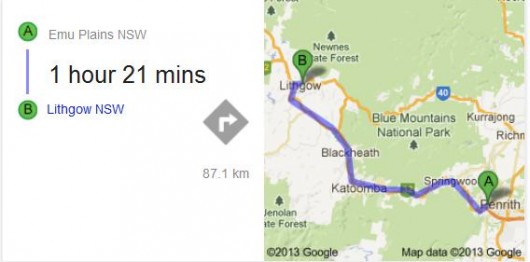Great Western Highway Trucking Deadly
Sunday, February 17th, 2013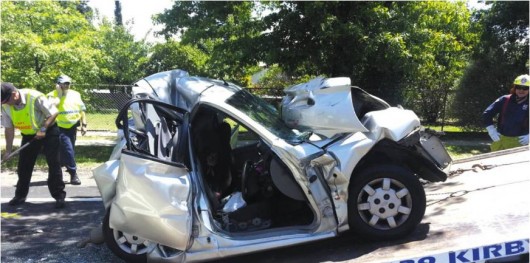 Crushed between two large trucks on the Great Western Highway
Blue Mountains, New South Wales, Australia
[Photo by Top Notch Video, Blue Mountains Gazette, 20130213, p.9]
Crushed between two large trucks on the Great Western Highway
Blue Mountains, New South Wales, Australia
[Photo by Top Notch Video, Blue Mountains Gazette, 20130213, p.9]
.
The Great Western Highway over the Blue Mountains west of Sydney is becoming an increasingly dangerous thoroughfare as the New South Wales Government steadily transforms it into a faster expressway designed for larger trucks and increasing the B-Double menace.
This highway is a regional route to towns like Bathurst and Orange and passes through many small towns and villages. Yet the trucking lobby and State Government don’t care about local safety or amenity. The wider and faster expressway is just carved through each town and village in turn, preventing safe crossing, dividing communities and prioritising the commercial imperatives of express road freight over human lives.
Hardly a week goes by without the local newspaper, the Blue Mountains Gazette, reporting a serious collision along our Great Western Highway.
All too frequently such collisions occur on the already widened expressway sections that are sold to the community as ‘safety upgrades’. All too frequently across the State and the country, we read about collisions on these expressways that have involved trucks – trucks speeding, trucks tailgating, trucks exceeding weight limits, drunk or drugged up truck drivers under the pressure of unrealistic delivery deadlines all hours of the day and night.
Local people who use these regional roads are now forced to confront larger and faster trucks, and B-doubles with trailers, hurtling along nudging above increased speed limits brought in by government planners. Ordinary road users are now risking the lives of themselves and their passengers as they are forced to increasingly share regional roads with the B-Double Menace.
.
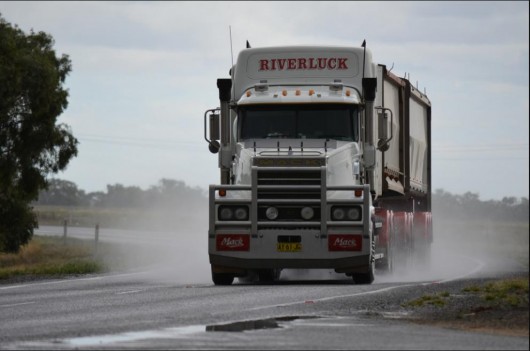 Get out of my way!
I’m on an unrealistic deadline!
(The B-Double Menace)
Get out of my way!
I’m on an unrealistic deadline!
(The B-Double Menace)
.
Just over a week ago, on the Great Western Highway at Blackheath, a Sydney woman driving in her car mid Wednesday morning toward the town of Orange braked behind a large truck that suddenly stopped on the highway in front of her. She glanced in the rear vision mirror only in horror to see a second large truck bearing down on her at speed. It slammed in to the back of her car, pushing her car compressed up against the large truck in front of her.
The woman, 34 year-old Sarina Heta was sandwiched in contorted metal that was her car, unable to escape and lucky to be alive. Her wrecked car, a Kia Rio sedan, is shown in the top photo.
Ms Heta was trapped in her car in a state of shock for 45 minutes until rescued by and the Fire Brigade and paramedics.
<<Blue Mountains emergency services were called to the scene about 10.50am where they found the woman trapped in her car. She was treated by ambulance officers while other emergency services workers spent an anxious 45 minutes working to safely remove her from the vehicle. Ms Heta was flown by helicopter to Westmead Hospital where she was in a stable condition and already reflecting on her miraculous survival.>>
.
“I remember just taking a big breath and taking the steering wheel and actually thinking it was over for me. I was a lucky girl that day with a group of angels looking over me. I just keep thinking, I must have done something good, or I have to do something amazing now I have another chance.” said Ms Heta.
.
Ed: This poor woman. It is plainly unjust that ordinary road users should have to experience life-threatening encounters with dangerous trucks.
.
- So why did the first truck stop on the highway?
- More importantly, why didn’t the second truck stop safely?
- Was the truck driver distracted talking on his mobile phone as many of these drivers frequently are observed, without being caught?
- Is the bastard still driving?
.
There are few if any police patrolling the highway. There is only one speed camera on the Great Western Highway and that is at Warrimoo over 30km away. These truck drivers are cowboys racing through the Blue Mountains as if they’re on a raceway and they couldn’t care less about any other road users. Other road users just get in their way.
Ordinary Blue Mountains road users have constantly complained about truck driver behaviour along the Great Western Highway; yet the State Government, local politicians and the police do nothing.
One resident wrote on social media: “The trucks very rarely travel at 60km through the town. . . There is no point trying to out run them as they are more powerful and you end up exceeding the speed limit,” wrote Alex Michie. “The road is fine . . . it’s the halfwits driving on it that is the problem,” wrote Josh Steel.
.
[Source: Lucky escape at Blackheath reignites highway safety debate’, 20130213, Blue Mountains Gazette newspaper, page 9, ^http://www.bluemountainsgazette.com.au/story/1298298/lucky-escape-at-blackheath-reignites-highway-safety-debate/].
A Trucking Expressway Government Mindset
.
Many of these large B-Double trucks cart sand, soil or rock into Sydney from quarry sites located in the Central West region of New South Wales. But when they are empty travelling out of Sydney, they rip along speeding over 90kph and tail-gating at all hours, menacing other road users.
A root cause of the truck speeding problem is that the truck drivers themselves are not paid by the hour. The transport industry remuneration structure has long surrendered Award-based pay for individual pay contracts. Truck drivers get paid not an hourly rate, but by the trip rate. The more trips a driver does, the more the driver gets paid, so speed has become a motivator for more pay.
This may make the job costing easier for the company accountants of the trucking companies or the corporate clients of the trucking companies, but it encourages unreasonably fast driving incentives which has dangerous implications for all road users, and the government allowing this must be held largely responsible and culpable.
Past local politician for the Blue Mountains, Bob Debus, approved hundreds of millions be spent transforming the regional highway into a trucking expressway a decade ago. This remains the State Government’s agenda.
Yet the Great Western Highway passes through twenty-one local communities over the Blue Mountains between the end of the M4 Motorway in outer Sydney and Lithgow, a road distance of 87km.
- Lapstone
- Glenbrook
- Blaxland
- Warrimoo
- Valley Heights
- Springwood
- Faulconbridge
- Linden
- Woodford
- Hazelbrook
- Lawson
- Bullaburra
- Wentworth Falls
- Leura
- Katoomba
- Medlow Bath
- Blackheath
- Mount Victoria
- Hartley
- Little Hartley
- Old Bowenfels
.
Many of these communities also have families and in many cases local schools. Many of these communities have their own 60kph maximum speed zones to allow for local street access, local traffic and indeed pedestrians of all ages. Many school crossings and school 40kph speed zones exist along the Great Western Highway. The encouragement of a 80kph trucking expressway transformation of the Great Western Highway is incongruent with its local use.
In some cases the government’s trucking expressway transformation of the highway has completely divided communities to the extent that there is no sign that a community even exists. When it was their turn, the communities of Lapstone and Linden succumbed entirely to the expressway imperative. Other communities are denied local vehicle access or access that is so contorted as to have made the local communities second rate citizens, like Warrimoo and now parts of Wentworth Falls.
When the expressway juggernaut came through town in Leura, Medlow Bath and Katoomba eight years or so ago, local properties were inundated by flash flooding caused directly by redirected highway stormwater design.
Recently Lawson and Hazelbrook have been witness to the bulldozing of heritage and amenity as the four lanes lobotomised their villages into a 80kph Blaxland byway.
As the expressway juggernaut arrives it carves through more native vegetation and habitat.
.
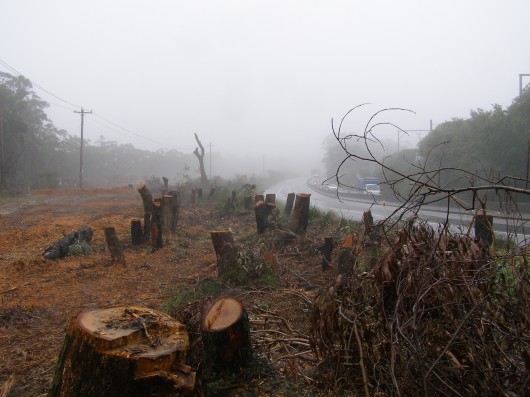 Destruction in progress at Boddington Hill in early 2012, east of Wentworth Falls
Great Western Highway, Blue Mountains, NSW
Destruction in progress at Boddington Hill in early 2012, east of Wentworth Falls
Great Western Highway, Blue Mountains, NSW(Photo by Editor 20120201, free in public domain, click photo to enlarge)
.
Bullaburra residents sensibly got involved in the expressway process early, drafted their own re-design for their community and thought that had a special deal with the RTA-come-RMS. But although the clever Government consultants have listened, the RTA has got its way. The trucks will be able to set their cruise control to nudge 85kph through this bucolic Bullaburra..
The trucking companies would like to minimise their transit times across the Blue Mountains, simply because in transport, time is money.
A recent trucking strategy has been to introduce bigger trucks so that more can be carted by each driver. This is why the Blue Mountains has seen a steady increase in B-Doubles – rigid trucks with a bogie trailer. On designated motorways in New South Wales, these B-Doubles are 26 metres long. In western Victoria and South Australia, B-Triples have been allowed, basically equating to the Road Trains of Outback Australia.
Also, most of these newer trucks have more powerful turbo diesel engines so that they can travel faster with the increased gross weights.
The 87km Blue Mountains section of the Great Western Highway lies between the end of the M4 Motorway at Emu Plains where trucks can sit on 110kph and Lithgow, where the highway opens up to 100kph passing by very few communities.
It is this populated variable speed 87km section that is the bane of the trucking companies and so their lobbying target to government to transform it into a trucking expressway to serve them. If the designated average travel time over the 87km Blue Mountains section is say 1 hour and 20 minutes, the cumulative billions being spent to transform the Great Western Highway into a trucking expressway could at the absolute best expect to save just 20 minutes truck transit time. This is even if all traffic lights and pedestrian crossings were removed so that the trucks could cruise on 90kph, through this Blue Mountains section.
Cost benefit analysis? Has it been done by anybody?
The proposed Mount Victoria bypass is set to cost over a billion dollars alone, to save perhaps just 2 minutes truck transit time.
.
The crazy planning Elephant in the Room that has been ignored in the wake of all these billions, is that once the trucks arrive in metropolitan Sydney, their transit times blow out in the congestion.
.
Our Editor wrote the following article which was published in the local Blue Mountains Gazette 7th January 2009. It is pertinent, because within a 100 metres or so of the truck collision that impacted Sarina Heta this month, another woman, Blackheath resident Betty Dowdell, was not so lucky.
.
Faster trucks Bob?
.
<<Blackheath resident Betty Dowdell was hit and run by a semi last month less than a truck length from Blackheath’s main intersection [SMH 16/12/08]. On 18th November a B-double caused a pile up on Richmond Road. Drug utensils were allegedly found in the driver’s compartment [SMH 19/11/08].
On 24 July around 3pm between Lawson and Bullaburra a Volvo B-double driver “lost control of the vehicle and collided head-on with a white light goods van heading west.” The 56-year-old Leura man driving the van was killed. [BMG 30/7/08].
On 3 October at 9.15am, a motorcyclist collided head-on with a semi-trailer on the wrong side of the Bells Line of Road at Mt Tomah [AAP 4/10/08]. On 29 March last year, a semi driver over-turned at Mt Vic. In 2004, on 25 February at 11pm a semi laden with mixed chemicals failed to negotiate a sharp bend at the bottom of Mt Vic pass. The truck rolled, killing the driver and spilling a load of hydrochloric acid and herbicide.
I recall driving back from Mt Tomah a few years ago with my family. An oncoming truck was well over the double lines and I was forced onto the gravel shoulder to avoid a head-on.
Speeding traffic is making our two highways more dangerous. Highway patrols and speed cameras are almost non-existent in the Mountains. Many collisions occur on sections of the highway that are already four lanes. Government policies are encouraging more, and bigger trucks to drive faster while rail options remain ignored.
Why is our federal member Bob Debus MP encouraging faster trucks through the Mountains?>>
.
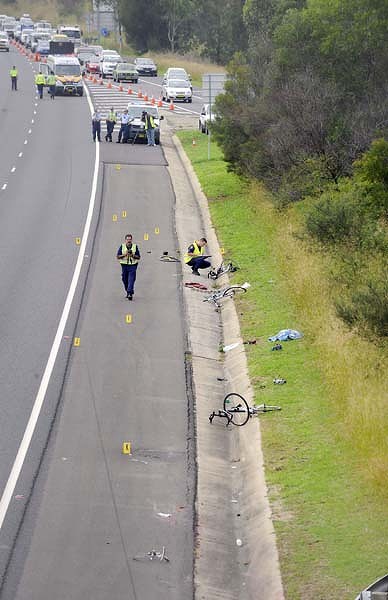 Just because highways are transformed into expressways, doesn’t make them safer.
This is the six-laned M4 motorway at Emu Plains.
A truck driver not concentrating, wiped out and killed cyclists out for a ride in the cycle lane.
10th April 2010.
May they rest in peace.
Just because highways are transformed into expressways, doesn’t make them safer.
This is the six-laned M4 motorway at Emu Plains.
A truck driver not concentrating, wiped out and killed cyclists out for a ride in the cycle lane.
10th April 2010.
May they rest in peace.
.
Footnote
.
On the other side of the M4 motorway from the above cyclist collision at Emu Plains, but this time heading east, a cyclist in the cycle lane was hit and killed by a car.
Blue Mountains resident, Marc Simone, 43, was cycling in the cycle lane at 7:30am Saturday 16th February 2013, when an incompetent P-plater veered and hit and killed Marc.
Marc had been training to cycle over 3,900 km to Darwin to raise money for Mission Australia.
[Source: ‘Marathon Mission Ends in Tragedy’, 20130220, journalist B.C. Lewis, Blue Mountains Gazette newspaper, p.1].
